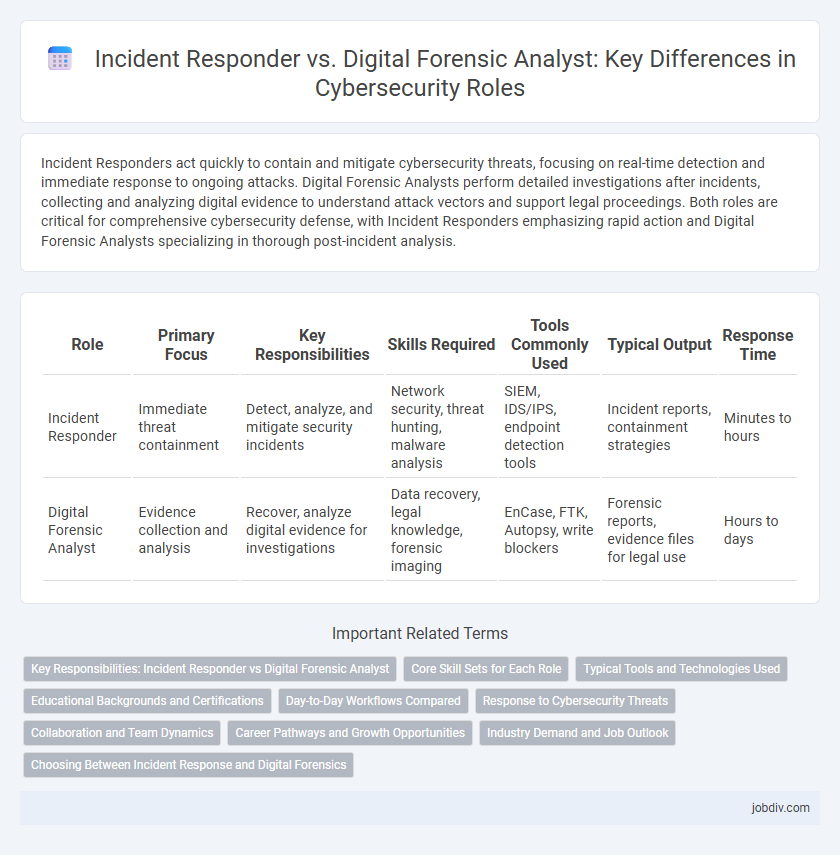Incident Responders act quickly to contain and mitigate cybersecurity threats, focusing on real-time detection and immediate response to ongoing attacks. Digital Forensic Analysts perform detailed investigations after incidents, collecting and analyzing digital evidence to understand attack vectors and support legal proceedings. Both roles are critical for comprehensive cybersecurity defense, with Incident Responders emphasizing rapid action and Digital Forensic Analysts specializing in thorough post-incident analysis.
Table of Comparison
| Role | Primary Focus | Key Responsibilities | Skills Required | Tools Commonly Used | Typical Output | Response Time |
|---|---|---|---|---|---|---|
| Incident Responder | Immediate threat containment | Detect, analyze, and mitigate security incidents | Network security, threat hunting, malware analysis | SIEM, IDS/IPS, endpoint detection tools | Incident reports, containment strategies | Minutes to hours |
| Digital Forensic Analyst | Evidence collection and analysis | Recover, analyze digital evidence for investigations | Data recovery, legal knowledge, forensic imaging | EnCase, FTK, Autopsy, write blockers | Forensic reports, evidence files for legal use | Hours to days |
Key Responsibilities: Incident Responder vs Digital Forensic Analyst
Incident Responders primarily focus on identifying, containing, and mitigating active security breaches to minimize damage and restore normal operations swiftly. Digital Forensic Analysts specialize in collecting, preserving, and analyzing digital evidence from compromised systems to support investigations and legal proceedings. Both roles are crucial for comprehensive cybersecurity, with responders addressing immediate threats and forensic analysts facilitating detailed post-incident examinations.
Core Skill Sets for Each Role
Incident Responders excel in rapid threat identification, containment, and mitigation, utilizing skills in network analysis, intrusion detection systems, and real-time incident handling. Digital Forensic Analysts specialize in evidence preservation, data recovery, and deep-level investigation using expertise in disk imaging, file system analysis, and forensic toolsets like EnCase or FTK. The ability to perform timeline reconstruction and apply legal standards for evidence admissibility distinguishes forensic analysts from incident responders focused on immediate threat neutralization.
Typical Tools and Technologies Used
Incident Responders typically use Security Information and Event Management (SIEM) platforms like Splunk and endpoint detection and response (EDR) tools such as CrowdStrike Falcon to quickly identify and contain cyber threats. Digital Forensic Analysts rely heavily on forensic suites like EnCase and FTK, as well as memory and disk imaging tools like Volatility and Autopsy, for in-depth evidence collection and analysis. Both roles require proficiency in network traffic analysis tools, including Wireshark, to effectively investigate and remediate security incidents.
Educational Backgrounds and Certifications
Incident Responders typically hold degrees in cybersecurity, information technology, or computer science, emphasizing certifications like GIAC Certified Incident Handler (GCIH) and Certified Information Systems Security Professional (CISSP). Digital Forensic Analysts often possess educational backgrounds in digital forensics, criminal justice, or computer science, favoring certifications such as Certified Computer Examiner (CCE) and GIAC Certified Forensic Analyst (GCFA). Both roles benefit from continuous training in emerging threats and forensic tools to enhance investigation and response effectiveness.
Day-to-Day Workflows Compared
Incident Responders prioritize rapid identification, containment, and mitigation of ongoing security breaches, continuously monitoring alerts and coordinating real-time response efforts. Digital Forensic Analysts focus on systematically collecting, preserving, and analyzing digital evidence to understand the attack vector, timeline, and extent of data compromise. Both roles utilize tools like SIEM, EDR, and forensic imaging software but differ in immediacy and depth of investigation during daily operations.
Response to Cybersecurity Threats
Incident Responders prioritize rapid containment and mitigation of cybersecurity threats by identifying attack vectors and neutralizing ongoing incidents to minimize damage. Digital Forensic Analysts focus on detailed evidence collection, analysis, and preservation to reconstruct the attack timeline and support legal or compliance actions. Both roles collaborate to strengthen organizational defense by combining immediate response with thorough investigation and strategic remediation.
Collaboration and Team Dynamics
Incident responders and digital forensic analysts collaborate closely to swiftly contain security breaches and preserve digital evidence for thorough investigation. Incident responders prioritize real-time threat mitigation and recovery, while digital forensic analysts focus on detailed evidence collection and analysis to support legal and compliance requirements. Effective team dynamics depend on synchronized communication and clearly defined roles to ensure rapid incident resolution and accurate forensic documentation.
Career Pathways and Growth Opportunities
Incident Responders prioritize rapid threat mitigation and real-time security breach management, honing skills in network analysis, intrusion detection, and incident handling. Digital Forensic Analysts specialize in evidence collection, data recovery, and detailed investigation of cybercrimes, building expertise in forensic software, legal protocols, and chain of custody. Career growth for Incident Responders often leads to roles like Security Operations Center (SOC) Manager or Threat Intelligence Analyst, while Digital Forensic Analysts can progress towards roles such as Cybercrime Investigator or Forensic Consultant.
Industry Demand and Job Outlook
Incident Responders are in high demand across cybersecurity sectors due to the increasing frequency of cyberattacks, with job growth projected at 22% over the next decade according to the U.S. Bureau of Labor Statistics. Digital Forensic Analysts also maintain strong industry demand, especially within law enforcement and corporate investigations, driven by the rising need for digital evidence analysis and cybercrime resolution. Both roles are critical in cybersecurity frameworks, but Incident Responders typically see a broader range of opportunities in real-time threat mitigation, while Digital Forensic Analysts specialize in post-incident data recovery and legal compliance.
Choosing Between Incident Response and Digital Forensics
Choosing between incident response and digital forensics depends on organizational priorities and incident goals; incident responders focus on real-time threat containment and system recovery, while digital forensic analysts specialize in evidence collection and analysis for legal or investigative purposes. Incident responders require skills in threat identification, mitigation tactics, and rapid decision-making, whereas digital forensic analysts demand expertise in data preservation, chain of custody, and forensic tools. Companies facing frequent attacks prioritize incident response to minimize downtime, while those involved in legal proceedings or regulatory compliance lean towards digital forensics for detailed investigation and proof.
Incident Responder vs Digital Forensic Analyst Infographic

 jobdiv.com
jobdiv.com